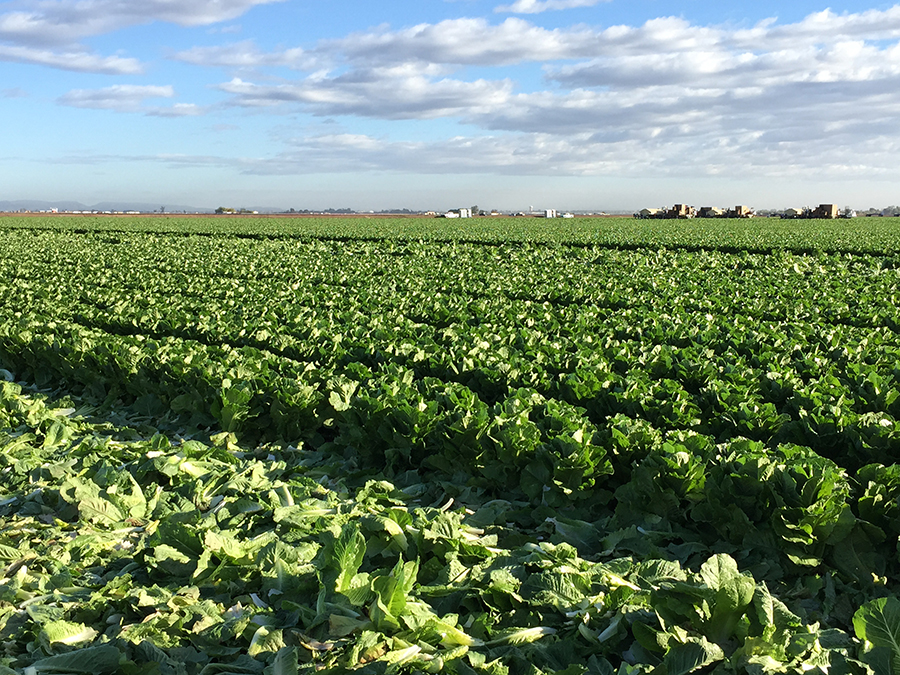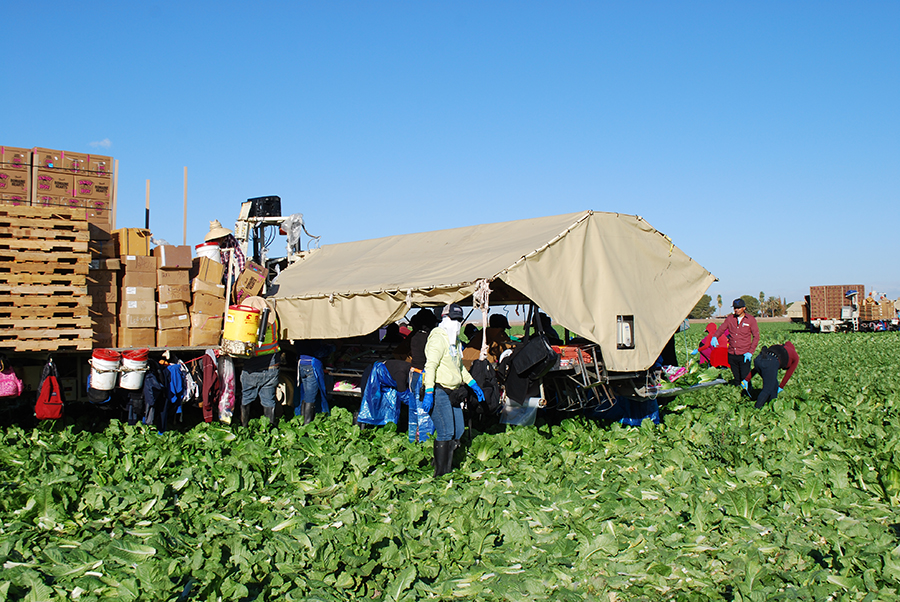
During our Yuma Legislative Tour in December, we saw miles and miles of lettuce, cotton, broccoli, seed crops, and more. We got muddy and trudged around the Romaine lettuce fields with migrant workers, and we also toured a cotton gin. (More photos are here on my Facebook page.)
After our first day of touring Yuma’s agricultural areas, we heard multiple presentations at a hosted dinner paid for by different growing/ranching industry groups and served up by 4H and JTED youth. The presentation by Paul Brierley, director of the University of Arizona Center of Excellence for Desert Agriculture, stuck out in my mind. He talked about using engineering technology to help growers in the Yuma area. According to the UA website, “The [Center of Excellence for Desert Agriculture], based in Yuma, is a public-private partnership (PPP) between the college and the Arizona and California desert agriculture industry, dedicated to addressing ‘on-the-ground’ industry needs through collaboration and research.” The website continues on to say: “More than two dozen industry partners from Yuma and Salinas, California, have invested in the center, together committing more than $1.1 million over the next three years.”
Brierley is an affable engineer who grew up on a large farm. According to Bierley, the primary problem that industry partners wanted the PPP center to tackle was “productivity”. He talked about different ways to boost productivity by using technology. For example, Brierley said that the date palms needed help with pollination. He showed a photo of a migrant worker pollinating date trees using a machine that looked like a leaf blower strapped on his back. This human-assisted pollination worked, but to improve productivity, the UA and Yuma growers began experimenting with drones. They found that drones to be more efficient pollinators than people. Technology to the rescue: mechanical birds. (For some jobs, this is the future: people being replaced by machines.)
Another problem area that had been identified as a hindrance to productivity was birds.
Birds– and four-legged creatures like dogs and coyotes– poo in the lettuce fields and create unsanitary conditions. Remember the e. coli outbreaks related to fresh spinach? Several growers and lobbyists expressed grave concern over any future e. coli outbreaks due to contaminated fresh produce. Now the UA folks and the growers boast that there are no footprints in the Yuma fields– not a bird track or a canine track anywhere.
I didn’t think much about those statements until I woke up bright and early the next morning to meet migrant workers as they crossed into the US for work at 5:30 a.m. While getting dressed, I realized that I had seen very few birds in the Yuma area– even at the 92,000-cow feed lot.
For the entire second day of my Yuma trip, I was on the lookout for birds. I shot more than 100 photos in two days with my iPhone and my Nikon DSRL; pretty much the only birds in any of my photos are the four birds in the feed lot photo. The biggest group of birds I saw in Yuma was a group of six pigeons on a rooftop in a residential neighborhood.
I was quietly freaking out about the environmental impact of no birds. Back on the tour bus, I asked a woman from the Department of Agriculture about “the bird problem”.
Referring to the previous evening’s talk, I asked her, “How did the ‘solve the bird problem’?” Brierley had mentioned visual things to confuse the birds and make them fly away; I envisioned the aluminum pie plates that state workers hung in the trees at Ohio State to scare away starlings and pigeons. I had not seen any dangling pie plates in trees (or many trees), scare crows, or visually confusing structures on the tour.
A man behind us piped up to answer my question: “We destroyed their habitat. That’s how we got rid of them.”
Me (old hippie flower child progressive): “You destroyed their habitat?! Birds and bugs are an important part of nature. Have you ever read Silent Spring?”
Him: “We had to do it. We don’t want another e. coli outbreak.”
Me: “I get that. People should wash their food.”
He basically agreed with me that people should wash their food, but they don’t. He repeated the lines from Brierley’s presentation the night before saying that these fields don’t have one bird track or one canine track because the growers don’t want any poo– or e. coli— in the fields. Proudly, he told me, “These fields are sterile.”
I have a masters in public health, and I obviously support avoiding an e. coli outbreak or any kind of outbreak. BUT, isn’t mass destruction of habitat a dramatic and environmentally risky response? Birds are nature’s bug control experts and little Johnny Apple Seeds all at the same time. They eat bugs, pollinate plants, and “deposit” plant seeds wherever they go. Birds and bugs are an important part of the fabric of nature. (Maybe growers wouldn’t need pollinating drones, if there was a healthy population of pollinating birds and bugs.)
Bird Watching
During the three-hour drive back to Tucson from Yuma, I continued my bird watching. Luckily, there was hardly any traffic on I-8. Except for the four birds at the 92,000-cow feed lot and the six pigeons in the Yuma neighborhood, I didn’t see any birds until I got to a rest stop west of Gila Bend– at least an hour of driving, if not longer. At the rest stop, a handful of sparrows swooshed past me as I got out of the car. Birds! They were nesting at the rest stop.
Between Yuma and Gila Bend, along I-8, the desert is very barren with few trees, cacti or wildflowers– just short scrubby creosote bushes and dirt. As I got to Gila Bend and beyond, the desert landscape was much more lush– cacti, palo verde trees, bushes, lots of colors– not just brown. The natural desert landscape east of Gila Bend is much healthier than the desert west of Gila Bend. Where the desert looked healthy is where I started to see birds again. East of Gila Bend– before reaching the farming in Pinal County– I saw two large predator birds, a small flock of medium-sized birds (maybe doves?), and two road runners. Through the farming areas of Pinal on I-8 and I-10, all the way to Marana, I saw no more birds– only patchworks of dirt alternating with fields of cotton or green plants (that are unidentifiable at 75 mph). Outside of Marana, a flock of 50+ birds flew across I-10. I was home.
Post Script…
Since my trip to Yuma, I had a long talk with a friend of mine who “grew up on a peasant farm” and was an environmental scientist in Yuma for many years. He said that my revelations about the sterile fields and destruction of trees (bird habitat) were not news and that these practices had been ongoing for a long time. He explained that farmers don’t want trees near the fields because the trees will suck up the water that is being used to irrigate the lettuce (since the Yuma fields are flooded to grow lettuce and other greens).
This got me to thinking about the dust bowl conditions along I-10 that have created haboobs and deadly driving conditions due to blowing dust. Back in the 1980s when I used to drive around Arizona, working for the rural electric co-op system, there were major stands of desert vegetation — palo verdes, mesquites, yucca, cacti, and wild flowers– along I-10 and in the median. These strips of desert between strips of asphalt and acres of farmland provided habitat for birds and animals, a wind break, and beautiful scenery for the drive. Heading west out of Tucson there are patchy remnants of ,the miles of lush palo verdes and mesquites that used to line the freeway.
Since my experiences in Yuma, I have become a bird and landscape observer when I’m driving. Try it. There are large expanses of land in Arizona where you won’t see many birds (or trees). In fact, I’ve seen more birds in downtown Phoenix than anywhere else lately.
Whether we like it or not, we humans are part of the natural world. We’re not the masters of it. Birds, bugs, animals, plants, soil, water, sun, air, people — we are all part of the Earth’s delicately balanced ecological system. When you break parts of the system, there are consequences — like the mass extinction of species, which is happening now. Let’s be wise stewards of our planet. Let’s work toward long-term sustainable living, instead of short-term profit.

Discover more from Blog for Arizona
Subscribe to get the latest posts sent to your email.

The Yuma guest worker program is an excellent example of how legal border crossings are a win-win for Mexico and the U.S.
Workers come and fulfill ag work needs and bring their wages back to their families and home towns, which promotes better life styles and economic development.
Rather than abandoning their families and sending back remittances, the workers strengthen their family ties and their communities.
A wall with large two-way doors is not a barrier to cross-country relations but a facilitator. Good fences can make good neighbors. It’s about mutual respect.